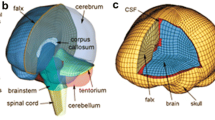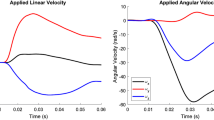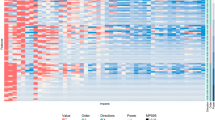Abstract
A number of human head finite element (FE) models have been developed from different research groups over the years to study the mechanisms of traumatic brain injury. These models can vary substantially in model features and parameters, making it important to evaluate whether simulation results from one model are readily comparable with another, and whether response-based injury thresholds established from a specific model can be generalized when a different model is employed. The purpose of this study is to parametrically compare regional brain mechanical responses from three validated head FE models to test the hypothesis that regional brain responses are dependent on the specific head model employed as well as the region of interest (ROI). The Dartmouth Scaled and Normalized Model (DSNM), the Simulated Injury Monitor (SIMon), and the Wayne State University Head Injury Model (WSUHIM) were selected for comparisons. For model input, 144 unique kinematic conditions were created to represent the range of head impacts sustained by male collegiate hockey players during play. These impacts encompass the 50th, 95th, and 99th percentile peak linear and rotational accelerations at 16 impact locations around the head. Five mechanical variables (strain, strain rate, strain × strain rate, stress, and pressure) in seven ROIs reported from the FE models were compared using Generalized Estimating Equation statistical models. Highly significant differences existed among FE models for nearly all output variables and ROIs. The WSUHIM produced substantially higher peak values for almost all output variables regardless of the ROI compared to the DSNM and SIMon models (p < 0.05). DSNM also produced significantly different stress and pressure compared with SIMon for all ROIs (p < 0.05), but such differences were not consistent across ROIs for other variables. Regardless of FE model, most output variables were highly correlated with linear and rotational peak accelerations. The significant disparities in regional brain responses across head models regardless of the output variables strongly suggest that model-predicted brain responses from one study should not be extended to other studies in which a different model is utilized. Consequently, response-based injury tolerance thresholds from a specific model should not be generalized to other studies either in which a different model is used. However, the similar relationships between regional responses and the linear/rotational peak accelerations suggest that each FE model can be used independently to assess regional brain responses to impact simulations in order to perform statistical correlations with medical images and/or well-selected experiments with documented injury findings.







Similar content being viewed by others
References
Beckwith, J. G., R. M. Greenwald, and J. J. Chu. Measuring head kinematics in football: correlation between the head impact telemetry system and Hybrid III headform. Ann. Biomed. Eng. 40(1):237–248, 2012.
Beckwith, J. G., et al. Biomechanical basis for mild traumatic brain injury: head impact exposure sustained by football players on days of diagnosed concussion. Med. Sci. Sports Exerc. 45(4):737–746, 2013.
Brainard, L. L., J. G. Beckwith, J. J. Chu, J. J. Crisco, T. W. McAllister, A. C. Duhaime, A. C. Maerlender, and R. M. Greenwald. Gender differences in head impacts sustained by collegiate ice hockey players. Med. Sci. Sports Exerc. 44(2):297–304, 2012.
Breedlove, E. L., M. Robinson, T. M. Talavage, K. E. Morigaki, U. Yoruk, K. O’Keefe, J. King, et al. Biomechanical correlates of symptomatic and asymptomatic neurophysiological impairment in high school football. J. Biomech. 45(7):1265–1272, 2012. doi:10.1016/j.jbiomech.2012.01.034.
Broglio, S. P., J. J. Sosnoff, S. Shin, X. He, C. Alcaraz, and J. Zimmerman. Head impacts during high school football: a biomechanical assessment. J. Athl. Train. 44(4):342–349, 2009.
Cloots, R. J., H. M. Gervaise, J. A. van Dommelen, and M. G. Geers. Biomechanics of traumatic brain injury: influences of the morphologic heterogeneities of the cerebral cortex. Ann. Biomed. Eng. 36(7):1203–1215, 2008.
Colgan, N. C., M. D. Gilchrist, and K. M. Curran. Applying DTI white matter orientations to finite element head models to examine diffuse TBI under high rotational accelerations. Prog. Biophys. Mol. Biol. 103(2–3):304–309, 2010.
Crisco, J. J., et al. Frequency and location of head impact exposures in individual collegiate football players. J. Athl. Train. 45(6):549–559, 2010.
Danelson, K. A., C. P. Geer, J. D. Stitzel, D. E. Slice, and E. G. Takhounts. Age and gender based biomechanical shape and size analysis of the pediatric brain. Stapp Car Crash J. 52:59–81, 2008.
Franklyn, M., B. Fildes, L. Zhang, K. H. Yang, and L. Sparke. Analysis of finite element models for head injury investigation: reconstruction of four real-world impacts. Stapp Car Crash J. 49:1–32, 2005.
Gadd, C. W. Use of a weighted impulse criterion for estimating injury hazard. In: 10th Stapp Car Crash Conference, Minneapolis, NM, SAE Paper 660793, 1966.
Gilchrist, M. D., and D. O’Donoghue. Simulation of the development of frontal head impact injury. Comput. Mech. 26:229–235, 2000.
Greenwald, R. M., J. T. Gwin, J. J. Chu, and J. J. Crisco. Head impact severity measures for evaluating mild traumatic brain injury risk exposure. Neurosurgery 62(4):789–798, 2008.
Hardy, W. N., C. D. Foster, M. J. Mason, K. H. Yang, A. I. King, and S. Tashman. Investigation of head injury mechanisms using neutral density technology and high-speed biplanar X-ray. Stapp Car Crash J. 45:337–368, 2001.
Hardy, W. N., M. J. Mason, C. D. Foster, C. S. Shah, J. M. Kopacz, K. H. Yang, A. I. King, J. Bishop, M. Bey, W. Anderst, and S. Tashman. A study of the response of the human cadaver head to impact. In: Proceedings of the 51st Stapp Car Crash Conference, SAE paper 2007-22-0002, 2007, pp. 17–80.
Horgan, T. J. A Finite Element Model of the Human Head for Use in the Study of Pedestrian Accidents. Galway: National University of Ireland, 2005.
Ji, S., J. C. Ford, R. M. Greenwald, J. G. Beckwith, K. D. Paulsen, L. A. Flashman, and T. W. McAllister. Automated subject-specific, hexahedral mesh generation via image registration. Finite Elem. Anal. Des. 47:1178–1185, 2011.
Ji, S., and S. Margulies. Brainstem motion within the skull: measurement of the Pons displacement in vivo. J. Biomech. 40(1):92–99, 2007.
Kimpara, H., Y. Nakahira, M. Iwamoto, K. Miki, K. Ichihara, S. Kawano, and T. Taguchi. Investigation of anteroposterior head-neck responses during severe frontal impacts using a brain-spinal cord complex FE model. Stapp Car Crash J. 50(November):509–544, 2006. Retrieved from http://www.ncbi.nlm.nih.gov/pubmed/17311175.
King, A. I., K. H. Yang, L. Zhang, W. N. Hardy, and D. C. Viano. Is head injury caused by linear or angular acceleration? In: Proceedings of IRCOBI Conference, Lisbon, Portugal, 2003.
Kleiven, S. Influence of impact direction on the human head in prediction of subdural hematoma. J. Neurotrauma 20(4):365–379, 2003.
Kleiven, S. Predictors for traumatic brain injuries evaluated through accident reconstructions. Stapp Car Crash J. 51:81–114, 2007.
Kleiven, S., and H. Von Holst. Consequences of head size following trauma to the human head. J. Biomech. 35(2):153–160, 2002.
Marjoux, D., D. Baumgartner, C. Deck, and R. Willinger. Head injury prediction capability of the HIC, HIP, SIMon and ULP criteria. Accid. Anal. Prev. 40:1135–1148, 2008.
McAllister, T. W., J. C. Ford, S. Ji, J. G. Beckwith, L. A. Flashman, K. D. Paulsen, and R. M. Greenwald. Maximum principal strain and strain rate associated with concussion diagnosis correlates with changes in corpus callosum white matter indices. Ann. Biomed. Eng. 40(1):127–140, 2011.
Meaney, D. F., and D. H. Smith. Biomechanics of concussion. Clin. Sports Med. 30:19–31, 2011.
Nahum, A. M., R. Smith, and C. C. Ward. Intracranial pressure dynamics during head impact. In: Proceedings of 21st Stapp Car Crash Conference. SAE Paper No. 770922. Society of Automotive Engineers, Warrendale, PA, 1977.
Newman, J. A. A generalized acceleration model for brain injury threshold (GAMBIT). In: International IRCOBI Conference on the Biomechanics of Impact, Zurich, Switzerland, pp. 121–131, 1986.
Newman, J. A., N. Shewchenko, and E. Welbourne. A proposed new biomechanical head injury assessment function—the maximum power index. In: 44th Stapp Car Crash Conference, Atlanta, GA, SAE paper 2000-01-SC16, 2000.
Post, A., and T. B. Hoshizaki. Mechanisms of brain impact injuries and their prediction: a review. Trauma 14(4):327–349, 2012.
Rowson, S., et al. Rotational head kinematics in football impacts: an injury risk function for concussion. Ann. Biomed. Eng. 40(1):1–13, 2012.
Sabet, A. A., E. Christoforou, B. Zatlin, G. M. Genin, and P. V. Bayly. Deformation of the human brain induced by mild angular head acceleration. J. Biomech. 41:307–315, 2008.
Takhounts, E. G., S. A. Ridella, V. Hasija, R. E. Tannous, J. Q. Campbell, D. Malone, K. Danelson, J. Stitzel, S. Rowson, and S. Duma. Investigation of Traumatic Brain Injuries Using the Next Generation of Simulated Injury Monitor (SIMon) Finite Element Head Model. Stapp Car Crash J. 52:1–31, 2008.
Trosseille, X., et al. Development of a F.E.M. of the human head according to a specific test protocol. In: Proceedings of 36th Stapp Car Crash Conference, SAE Paper No. 922527, 1992.
Versace, J. A review of the severity index. In: 15th Stapp Car Crash Conference, Coronado, CA, SAE paper 710881, 1971.
Viano, D. C., I. R. Casson, E. J. Pellman, L. Zhang, K. H. Yang, and A. I. King. Concussion in professional football: brain responses by finite element analysis – Part 9. Neurosurgery 57:891–916, 2005.
Weaver, A. A., K. A. Danelson, and J. D. Stitzel. Modeling Brain Injury Response for Rotational Velocities of Varying Directions and Magnitudes. Ann. Biomed. Eng. 40(9):2005–2018, 2012.
Yang, K. H., J. Hu, N. A. White, A. I. King, C. C. Chou, and P. Prasad. Development of numerical models for injury biomechanics research: a review of 50 years of publications in the Stapp Car Crash Conference. Stapp Car Crash J. 50:429–490, 2006.
Yang, K., H. Mao, C. Wagner, F. Zhu, C. C. Chou, and A. I. King. Modeling of the brain for injury prevention. In: Studies in Mechanobiology, Tissue Engineering and Biomaterials. Berlin: Springer, 2011, pp. 69–120.
Zhang, L., P. Begeman, and J. Melvin. Brain injury prediction for Indy race car drivers using finite element model of the human head. In: SAE Transactions, SAE Technical Paper 2004-01-3539. Warrandale: Society of Automotive Engineers, 2004.
Zhang, L., and T. Gennarelli. Mathematical modeling of diffuse brain injury: correlations of foci and severity of brain strain with clinical symptoms and pathology. In: IRCOBI Impact Biomechanics, pp. 315–324, 2011.
Zhang, L., K. H. Yang, and A. I. King. A proposed injury threshold for mild traumatic brain injury. J. Biomech. Eng. 126:226–236, 2004.
Acknowledgments
We would like to thank Dr. Erik Takhounts for providing support with the SIMon model. This work was supported by the National Operating Committee on Standards for Athletic Equipment (NOCSAE 07-04, 14-19) and by the National Institute for Child Health and Human Development at the National Institutes of Health (R01HD048638). HIT System technology was developed in part under NIH R44HD40473 and research and development support from Riddell, Inc. (Chicago, IL).
Conflict of interest
Richard M. Greenwald, Jonathan G. Beckwith, and Simbex have a financial interest in the instruments [HIT System, Sideline Response System (Riddell, Inc.)] that were used to collect data used in this study. The remaining authors have no financial interests associated with this study.
Author information
Authors and Affiliations
Corresponding author
Additional information
Associate Editor Stefan M Duma oversaw the review of this article.
Appendices
Appendices
The following tables report comparisons of the meshes and runtimes (Table A1) and the material properties for the various components of the brain (Tables A2–A4) for the three models.
Rights and permissions
About this article
Cite this article
Ji, S., Ghadyani, H., Bolander, R.P. et al. Parametric Comparisons of Intracranial Mechanical Responses from Three Validated Finite Element Models of the Human Head. Ann Biomed Eng 42, 11–24 (2014). https://doi.org/10.1007/s10439-013-0907-2
Received:
Accepted:
Published:
Issue Date:
DOI: https://doi.org/10.1007/s10439-013-0907-2




